HiPP Dutch New vs. Old Style
47 hours of research 5 minute read

HiPP is amongst the most trusted infant formula manufacturers in Europe and the United States. It is also considered the most popular organic infant formula brand in Germany. While the formula was introduced more than half a century ago, the Dutch version of the formula known as HiPP Dutch has become the most sought-after formula milk by parents. Commercial surveys have shown that amongst the parents who were asked about their favorite milk formulas for their infant, 93% recommended HiPP Dutch Milk. This is because, over the years, the company has continuously innovated and improved according to the latest health guidelines and nutritional research with time.
Hence it helped the company when it began introducing enhanced versions of HiPP formulas from October 2021 onwards. All of these improved formulas are more or less similar to the previous formulas, with the most notable difference being the switch from folic acid to Metafolin (both of which help prevent folate deficiency). With Metafolin's success, popular HiPP formulas like HiPP Bio Combiotic, HiPP Hypoallergenic Bio Combiotic, HiPP Anti Reflux Bio Combiotic, and Comfort Bio Combiotic Formula - all of them now include Metafolin.
Main Differences Between The New And Old HiPP Dutch Formulas
HiPP Dutch formula has always contained a unique blend of natural probiotic lactic acid cultures made to mirror human breast milk. This makes the formula almost identical to breast milk and much easier for the baby to accept. Moreover, these formulas do not contain any externally added starch. Instead, the main carbohydrate in the HiP Dutch Formulas is Lactose - just like that found in natural breast milk.
Every HiPP Formula has the additional benefit of being EU organic certified. This means that the milk that is used in the formulas comes from supervised and biodynamic farms that are not only chemical free but also environmentally safe. HiPP Duct believes in providing a baby with the best of the best - which is why HiPP Dutch is also free from all artificial sweeteners and possible allergens like eggs, soy, and gluten. In order to further improve the quality and benefit to the infant consuming the formula, HiPP Dutch has introduced an enhancement to its popular formulation, which is almost like the previous one but with a few improvements.
While the New Formulation is currently available for Stage 1 and Stage 2 of infant formula and follow on milk, the old formulation includes stage 3 as well. Stage 1 is ideal for babies up to six months of age, while stage 2 is ideal for babies between the ages of 6 months and one year. While the contents of stage 1 and stage 2 are similar, the latter contains a higher amount of iron and vitamin D. Stage 3 is a special formulation that can be given to toddlers after their age has increased from the first year.
1. Nutritional Differences & Improvements
Besides adding Metafolin to the new HiPP Dutch formulation, there are minor nutritional differences between the old and the new formula. For 100 ml of HiPP Dutch Infant milk, the old formula provided a total energy of 276 kJ, the same as the new formula. The nutritional contents are also identical for the total fats, DHA, Carbohydrates, Fibers, and Lactose.
However, while the old formula contains 66 mg of Potassium for a 100 ml serving, the new formula contains 76 mg per 100 ml. While the difference is minimal, the increased concentration of Potassium may benefit the baby by allowing an improved fluid balance and maintenance of healthy blood pressure.
The levels of Vitamin B1 are also higher in the updated formula. For example, while the old formula contained 0.036 mg of Vitamin B1 per 100 ml, the newer formula contained 0.05 mg. This benefits the baby, as Vitamin B1 plays an essential role in the heart, nerve, and muscle functions.
On the other hand, the Niacin content is slightly lower in the new formula than in the old. The Niacin content in the old formula was 0.34, while that in the new formula is 0.029 mg.
2. Addition of Metafolin
The major difference between the old and new HiPP Dutch formula is the presence of Metafolin. Metafolin is a natural form of Vitamin B9, which is also found in human breast milk. Vitamin B9, also known as folate, plays an important role in the growth and development of the baby - before and after their birth.
Previously, Folic acid was the most commonly consumed form of folate in baby formulas; however, newer research has shown an increased bioavailability and effectiveness of Metafolin. The increased bioavailability and simpler formula allow this form of folate to be metabolized much more easily in the digestive tract. The newer formulation of the HiPP Dutch is an improvement from the previous formula due to the addition of Metafolin in place of folic acid. This is a much more reliable source of Vitamin B9 and helps the baby's development. It does this by allowing the formation of new cells and genetic material like DNA and RNA. The new formulation of HiPP Dutch with Metafolin also contains lactic acid and probiotics, which have been derived from human breast milk.
More information about Metafolin can be found in our extensive Metafolin guide & review.
MANUFACTURER'S NOTE: The Importance of Folate For Babies
Folate is an essential nutrient that is found in plants and animals. It is even found in human breast milk. It has a number of functions in the body, both during and after pregnancy. It is required for the basic functioning of cells and promotes cell processes like cell formation, cell differentiation, and cell regeneration. Among the most important folate role in the body is the formation of blood and cognitive development.
Benefits Of New Style HiPP Dutch Formula
Studies have shown that babies who are being fed Metafolin have many more health benefits as compared to the babies being fed folic acid. This is because the majority of the babies given folic acid are unable to metabolize it, and they are found to have high levels of unmetabolized folic acid in their bodies. This is because young babies are unable to convert folic acid to its ready-to-use form. This is because a majority of enzymes in the liver of the baby are not yet active enough or have limited activity. Since Metafolin is already a bioactive form of folate, their livers don't have to do the extra work, and it is much easier for them to metabolize it. Health experts believe that the use of Metafolin is also a safer alternative to synthetic folic acid to ensure an adequate supply of folate to babies who are not breastfed. However, this does not require to be given on its own but may also be given supplementary to the natural breast milk as well.
HiPP Dutch Stage 1 Old vs. New Comparison
| Old Style | New Style | |
|---|---|---|
| Vitamin D | 1.5 micrograms | 1.6 micrograms |
| Vitamin C | 8.9 milligrams | 10 milligrams |
| Calcium | 51 mg | 70 mg |
| Potassium | 66 mg | 76 mg |
Benefits Of New HiPP Dutch Stage 1
- Higher vitamin D level ensures better calcium and phosphorus absorption.
- Higher Vitamin C levels ensure a better immunity for the developing baby.
- Higher calcium levels ensure healthy and strong bones.
- Higher potassium levels ensure the maintenance of fluid levels in the body.
HiPP Dutch 1 New Packaging
With the introduction of Metafolin into its Stage 1 formulation, HiPP Dutch packaging was refreshed in mid 2022. Visible differences are statements calling out “Metafolin” on the front, as well as updated ingredient lists and nutritional values. The mixing instructions remained unchanged.
HiPP Dutch 1 New Style Packaging
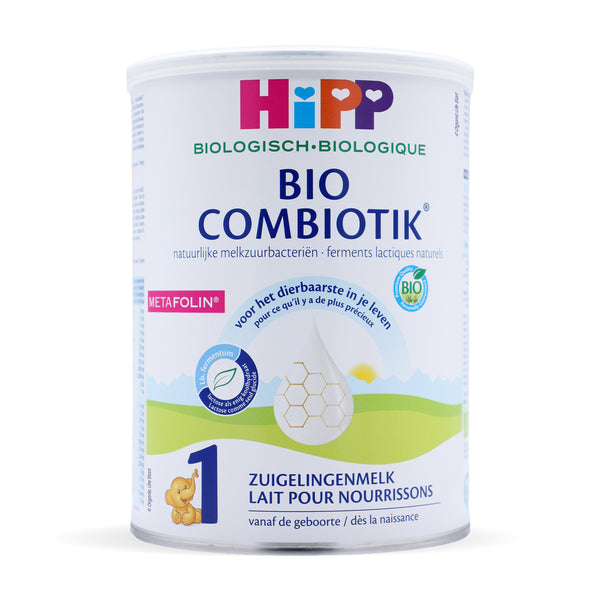
HiPP Dutch 1 Old Style

HiPP Dutch Stage 2 Old Vs. New Comparison
| Old Style | New Style | |
|---|---|---|
| Vitamin K | 3.1 micrograms | 3.9 micrograms |
| Vitamin B1 | 0.037 milligrams | 0.051 milligrams |
| Folate | 10 microgram | 11.3 microgram |
| Calcium | 70 milligram | 77 milligrams |
Benefits Of New HiPP Dutch Stage 2
- Higher vitamin K level ensures proper clotting of blood and protects the babies from excessive bleeding.
- Higher Vitamin B1 levels ensure proper development of the nervous and muscular system of the baby.
- Higher Folate levels ensure new cells and DNA formation in the body.
- Higher calcium levels help ensure healthy and strong bones.
HiPP Dutch 2 New Packaging
With the introduction of Metafolin into its Stage 2 formulation, HiPP Dutch packaging was refreshed in mid 2022. Visible differences are statements calling out “Metafolin” on the front, as well as updated ingredient lists and nutritional values. The mixing instructions remained unchanged.
HiPP Dutch 2 New Style Packaging
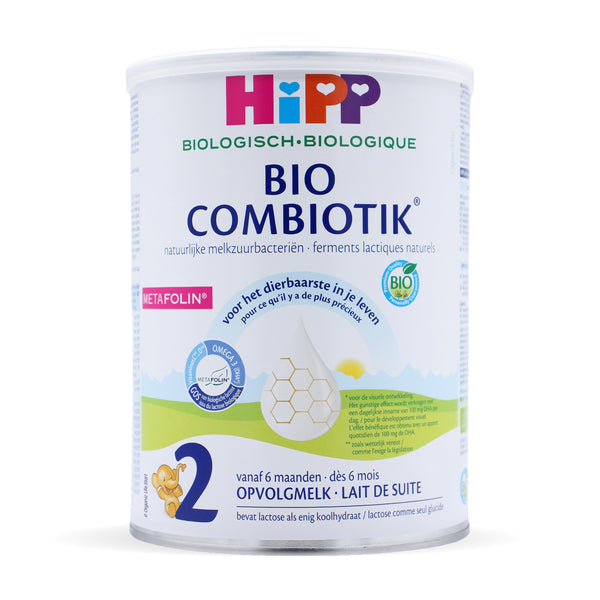
HiPP Dutch 2 Old Style

HiPP Dutch Stage 3 Old Vs. New Comparison
| Old Style | New Style | |
|---|---|---|
| Potassium | 80 micrograms | 88 micrograms |
| Vitamin B1 | 0.032 milligrams | 0.045 milligrams |
| Vitamin K | 3.1 microgram | 3.4 microgram |
| Biotin | 1.6 micrograms | 2.5 micrograms |
Benefits Of New HiPP Dutch Stage 3
- Higher vitamin K level ensures proper clotting of blood and protects the babies from excessive bleeding.
- Higher Vitamin B1 levels ensure proper development of the nervous and muscular system of the baby.
- Higher Potassium levels ensure maintenance of fluid levels in the body..
- Higher Biotin levels ensure proper breakdown of food and release of energy to fuel the baby’s body functions and processes.
HiPP Dutch 3 New Packaging
With the introduction of Metafolin into its Stage 3 formulation, HiPP Dutch packaging was refreshed in mid 2022. Visible differences are statements calling out “Metafolin” on the front, as well as updated ingredient lists and nutritional values. The mixing instructions remained unchanged.
HiPP Dutch 3 New Style Packaging
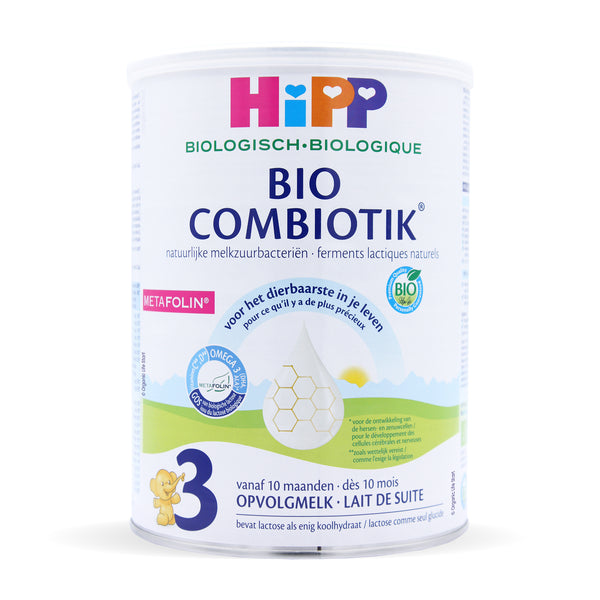
HiPP Dutch 3 Old Style

How To Prepare HiPP Dutch Baby Formula?
When preparing baby formula, it is important to follow the manufacturer's instructions. Improper storage or improper preparation of the baby formula can lead to adverse health effects for the baby. Preparing fresh batches of milk before feeding the baby is recommended, rather than storing the milk for prolonged periods. This prevents the growth of unwanted pathogens.
Before preparing the milk, the parents should start by carefully cleaning every part of the baby bottle - whether it is the bottle, the nipple, or the ring. Once this is done, measured water should be brought to a boil and then allowed to cool to a temperature of 40 to 50 degrees. After the water has reached the right temperature, it should be added to a vial. Using water that is too hot can damage the lactobacilli present in the milk. The recommended amount of powder should be measured using a measuring spoon and then added to the water in the vial. The water and formula mixture should be mixed properly by shaking the bottle several times. The prepared formula milk should then be allowed to cool to 37 degrees before being fed to the baby.
HiPP Dutch Changes - In Summary
Even though there are not a lot of differences between the new and old formulations of HiPP Dutch, the subtle differences make all the impact. The addition of Metafolin as a source of folate instead of folic acid is the most noticeable change in the new formula. It allows the developing digestive tract of the baby easy access to folate. It does not have to work overtime to break it down and convert it into a form that the body may use. Instead, Metafolin is a natural form of Vitamin B9, which is similar to that found in human breast milk. It is bioactive; hence, it can be easily metabolized in the body. Currently, the HiPP Dutch with Metafolin is only available in stages 1 and 2 of the formula milk; hence may only be available to babies up to the age of 1 year. Stage 1 is formulated to be fed to babies from birth until they turn six months old. While stage 2 is ideal for babies between the age group of 6 months to 1 year.
Most Popular HiPP Dutch Formulas
Organic Life Start is committed to providing accurate, reliable, and trustworthy information to parents and caregivers. We carefully choose credible sources and follow a meticulous fact-checking process to uphold the highest standards in infant nutrition and parenting advice. To learn more about our dedication to accuracy, please explore our editorial guidelines.
Link To Sources
- https://badgut.org/information-centre/a-z-digestive-topics/probiotic-treatment-for-kids-with-uc/
- https://newmodernmom.com/blog/how-to-pick-a-baby-formula/
- https://www.healthychildren.org/English/ages-stages/baby/formula-feeding/Pages/Choosing-an-Infant-Formula.aspx
- https://www.nytimes.com/wirecutter/blog/us-parents-european-baby-formula/
- https://www.hometownstation.com/featured-stories/how-is-the-hipp-formula-better-than-other-formulas-480544


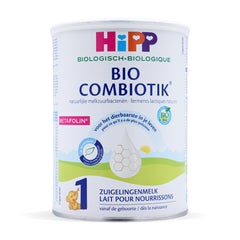
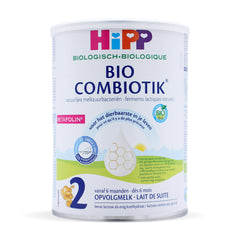







Roger M -
I read about the new-style HiPP Dutch packaging and formula updates, but I’m not sure if it’s worth switching from the old version. Does anyone have firsthand experience? It’s hard to know if changes like this are just cosmetic or if they actually impact what our babies are getting. This breakdown helped me understand what’s different—from the can design to the ingredient tweaks—and eased some of my worries. Still, I’d love to hear from other parents who’ve made the switch!
Jessica M -
I read about the new HiPP Dutch formula with Metafolin and wasn’t sure if the change really mattered, but we decided to try it anyway. My baby had been doing fine on the old version, but I noticed she seemed to digest the new one even easier—less fussiness after feeding. I like knowing that Metafolin is more like what’s in breast milk and easier for babies to absorb. It gave me extra peace of mind, especially since we started using it from birth. If you’re on the fence, I’d say it’s definitely worth considering!
Ronan V -
At first, I was skeptical in using the new style. My baby has been taking the old style with no issues at all. But since the inventory of the old style has been depleting, we have tried the new style, and Baby still loves it. I am happy and relieved that it worked out.